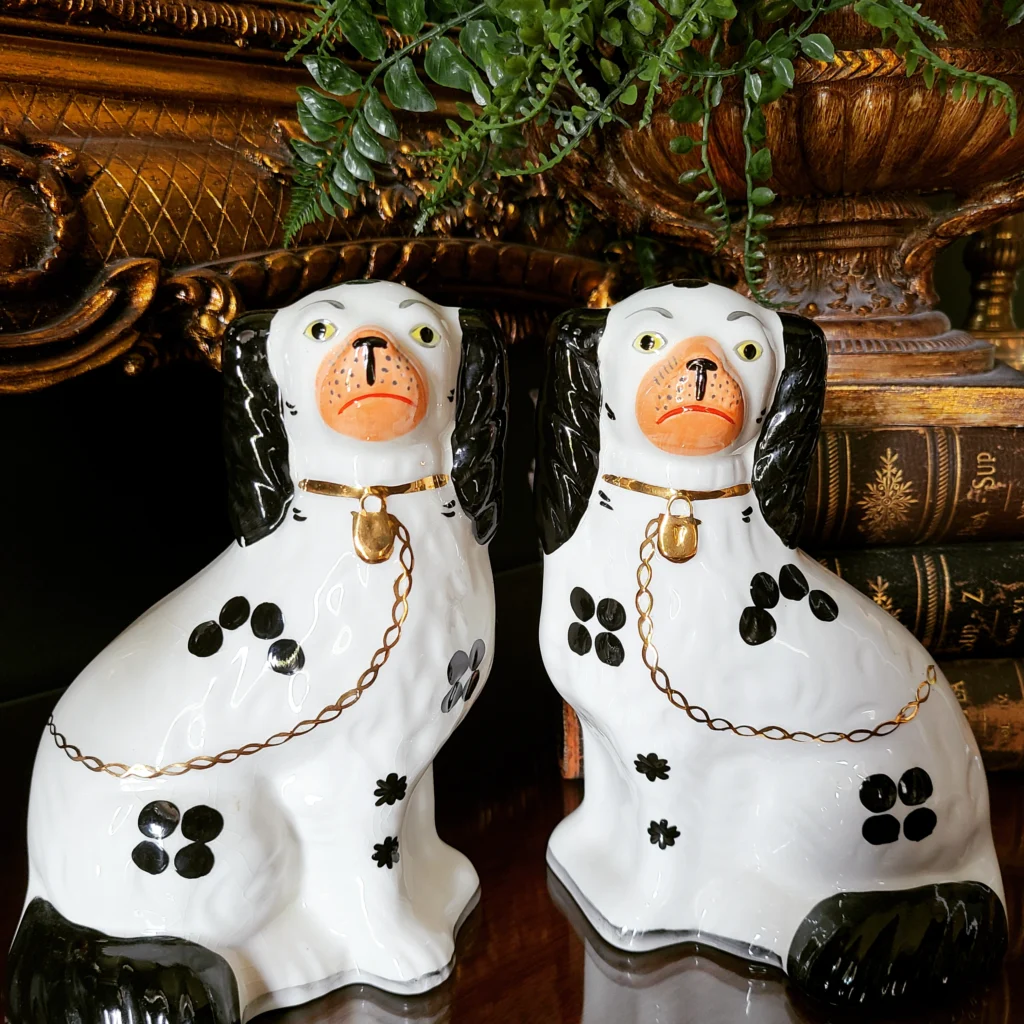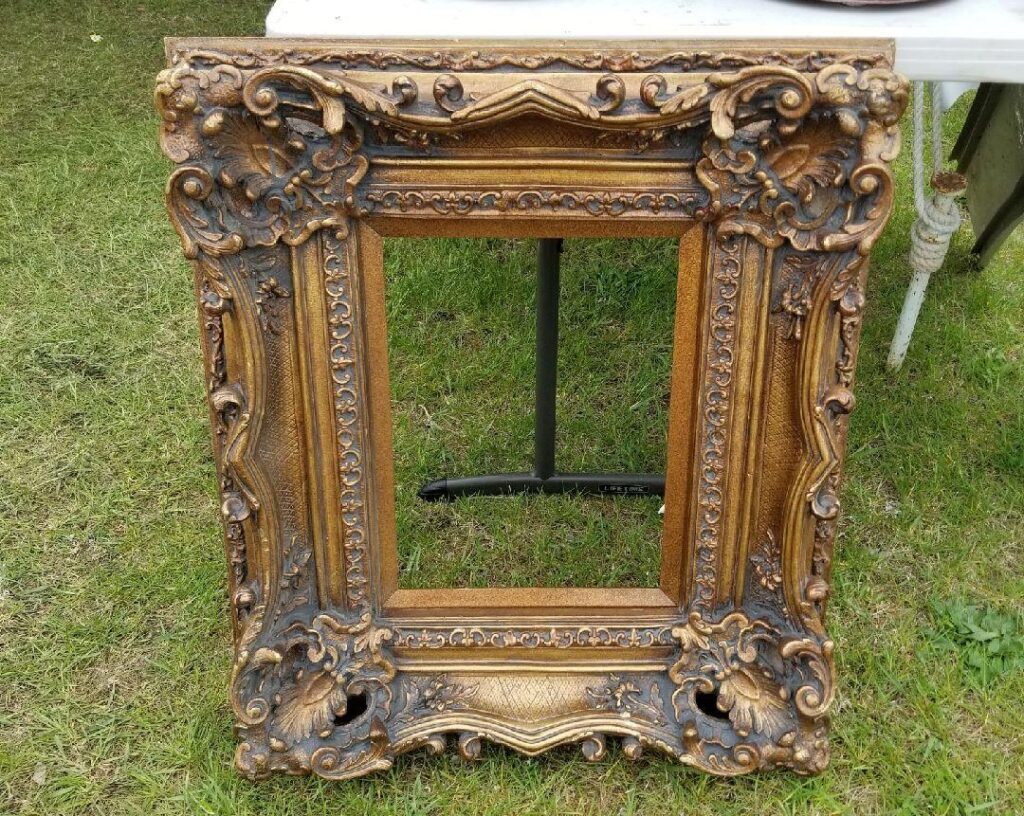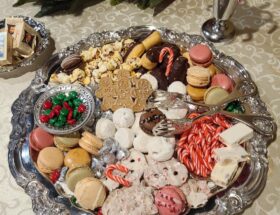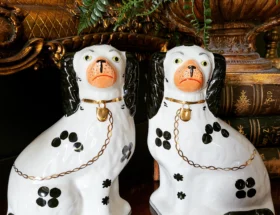It is flea market season! Do you know what that means? Let the treasure hunt begin! And it is literally a treasure hunt! If you have ever been to a flea market you understand that about the 90% of the items are junk or simply items you are not interested in. Let me repeat, 90% of the items are junk or not cool enough to strike your fancy. It’s the magical 10% you need to hunt for!
Below are the five tips for successful flea market shopping:

A pair of Staffordshire dogs from England! Now situated in my home!
Tip 2: Be Prepared: If you were going on a real-life treasure hunt, I am willing to bet you would start your journey prepared. With flea market shopping it is the same concept because you are literally digging for gold! It is just like normal shopping, but outdoors, no shopping carts, cash is preferred, lots of walking, and more stuff to look through! With that being said you need to pack for success. I suggest the following packing list:
- Mostly cash, some vendors do accept credit cards and checks, but cash generally is preferred.
- Pack an umbrella and sunblock.
- Wear comfortable shoes.
- Dress in layers to either remove or add clothing as needed.
- Bring a wagon to carry larger items purchased or bags for smaller items.
- Drive a larger vehicle (van, truck or vehicle with a larger cargo area) to the flea market if you are in the market to purchase a larger item or in the event you randomly purchase a larger item, like a piece of furniture.
- Pack snacks and bring a bottle of water to keep you fueled and hydrated.
- Hand sanitizer. Restroom facilities are limited at many flea markets, making it more difficult to keep your hands clean.
- Bring a tape measure to ensure the item you are interested in will fit in its intended space or even in your vehicle. This is a good item to have…trust me…I have been burned in the past with buying items too large for my vehicle or for the space I intended.
Tip 3: Be Knowledgeable: Do real-life treasure hunters/explorers start their adventure without preparing beforehand? I think not. They review a map, plan their time, know what they are looking for, and understand what to watch out for. Thinking about it that way, before you visit the flea market, I recommend you plan accordingly. Some top-level tips are listed below:
- Review the flea market website so you know the location, hours of operation, entry fee, parking situation, etc.
- Once you arrive, do a walk through so you have an understand the terrain before you go digging for gold.
- Arrive early! Arriving early gives you an advantage because you have first dibs on the goods!
- Arriving later or staying late has its advantages too though. This is because vendors often lower prices at the end of the day in an effort to get rid of inventory. If the flea market is going on for multiple days, the last day of the market has the lowest prices.
- Bargain in a politely and only do so if you are interested in an item.
Tip 4: Be Studious: To take being prepared to the next level by doing your homework up front and educating yourself. Prior to visiting the flea market make sure you understand how to determine if something is valuable, high quality, a reputable name brand, a diamond in the rough, etc. You can do so by visiting high-end furniture stores in your area and taking note of some of the brand names you see. Examples include Drexel, Baker, Henredon, Karges, Maitland-Smith, Stickley, Kindel, Kittinger, Hekman, etc. You may also visit high quality furniture websites, doing a google search or thumbing through at home decor magazines to do this if you cannot physically go to a furniture store. You can usually find the furniture manufacturer label inside a drawer, underneath the piece of furniture or under a sofa cushion.

Muller onyx table! Beautiful silver tea set! Table is now displayed in my foyer!
If you cannot find the brand name or are unsure about the value of an item at the flea market, you can ask yourself the following questions to help assess value:
- Is it well made? Does it look like a lot of time and effort were put into constructing it versus it having a mass-produced look? Does it wobble? If it is well made and is sturdy then it signifies high quality.
- Is the type of material high quality? Does it seem to have lasting ability? Does the fabric feel thick and tight? If so, this means expensive. Examples are leather, velvet, damask, tapestry and silk.
- Is the piece heavy and solid? Does it contain carvings and details? Nail heads (decorative embellishments)? If the piece is super heavy, carved, ornate, and feels solid then it also is sign of high-end furniture. I always lift chairs, tables, ottomans, etc. when I visit flea markets and if I can barely lift them, I know I am looking at something that is higher quality. Beware of furniture that is made to look old or luxurious, but not make of real solid wood. Laminate-covered particleboard is considered lower quality and not considered valuable.
Assessing the value of pottery and silver pieces is similar to furniture guidelines. Questions to ask are, is the item sturdy, solid, thick, good condition, no fading, appearing to be well made, etc. Knowing brand names can help too. Sought after porcelain brands are Limoges, Royal Doulton, Meissen, Wedgewood, Spode, etc. Does the item have a stamp on the bottom? Silver pieces (silver plated) can be handled the same way and look you can look for stamps on these items as well. Some reputable brands are Rogers, Gorham, Reed & Barton, Tiffany & Co. Stamps are also important things to look out for when looking at a piece of silver. Sterling silver is very valuable. Common stamps that signify sterling silver are 92.5, .925, 925, Ster, Sterling, Sterling Silver.
I understand it is a lot to take in, but remember technology is on our side in today’s world. If you are not sure about something you see at a flea market, but are interested and unsure about how the value you can use your smart phone to look the item up. You can do a quick Google search you can see what the average price of the item or something similar is. I have the Google Lens app which uses a picture to prompt the search. This is helpful if you do not know the name of an item. You can simply use the lens to take a picture and voila, the results are in!
Tip 5: Be Alert: Keep in mind that shopping at a flea market is not like shopping at a regular store. If you see something you are interested in you need to act fast. Sometimes taking time to think something over or stepping away for a few minutes could mean missing out on something amazing. And if the item is really awesome, someone else could also be scoping it out , ready to pounce as soon as you walk away. A lot of items you find at the flea market are rare or considered to be one of a kind. I’ve missed out on items myself and even had some close calls at flea markets and estate sales.
In addition to being alert, you need to also be mindful of what items are valuable (see tips above), because this will help you barter more successfully with vendors. Knowing if something is considered valuable will ensure you barter politely because you are less likely to offer an unrealistic amount. If you are unsure about an item, but really like it, you can barter nicely by stating “how much are you willing to go down on this item?”
There you have it, the five bes of flea market shopping! Set forth on your journey and hunt for treasures! Remember to have fun! That is the most important thing!
Lastly, as inspiration for you, I wanted to include some photos of flea market items I picked up while treasure hunting. See below:

Ornate gold frame!

Ornate frame with a mirror in it. Now hanging in my son’s nursery!

Vintage Fan!
Happy treasure hunting!







Wow, this is very informative, I love flea marketing. That is one of the items on my bucket list, visit all or as many flea markets in the US and I will keep this article for future reference.
Flea marketing is so much! How cool that you went to various flea markets across the US!